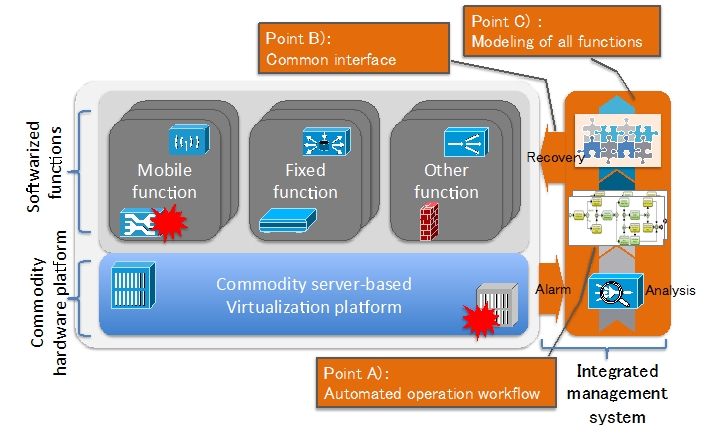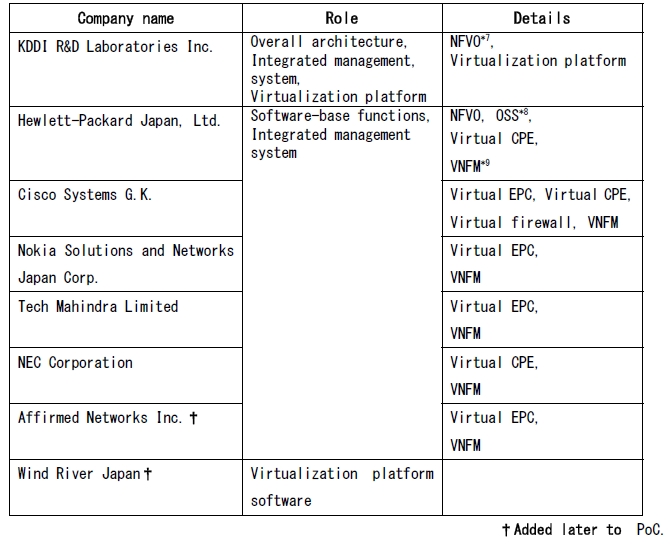 Print
Print
Successful PoC of automated operation for SDN/NFV era
June 29, 2015
KDDI R&D Laboratories, Inc.
KDDI R&D Laboratories Inc. (“KDDI R&D labs”, President & CEO, Yasuyuki Nakajima), in cooperation with Hewlett-Packard Japan, Ltd. (Managing Director, Hitoshi Yoshida), Cisco Systems G.K. (President and General Manager, Miyuki Suzuki), Nokia Solutions and Networks Japan Corp. (President, Juha-Pekka Takala), Tech Mahindra Limited (Head, Amitava Ghosh), and NEC Corporation (President (Representative Director), Nobuhiro Endo) has successfully completed world’s first proof of concept (PoC) of fully automated, closed-loop operation process for telecom networks consisting of virtualized equipment for mobile and fixed services. Adding virtualization equipment from Affirmed Networks Inc. (CEO, Hassan Ahmed) and an NFV infrastructure software platform software from Wind River Japan (President, Michikazu Fujiyoshi), KDDI R&D labs will accelerate the PoC and standardization activities to enable an advanced operation in the SDN/NFV era.
Highlights from the automated operation mentioned above was demonstrated at “TM Forum Live! 2015” from 1 June in Nice, France, and Interop SDI ShowCase from 10 June in Makuhari, Japan. The demonstration is awarded “Best application of Frameworx”from TM Forum Live! 2015. With these initiatives leveraging SDN/NFV technologies, KDDI R&D labs will contribute to realize the 5th generation mobile infrastructure which provides both of flexible support for diversifying service requirements and improved operation quality.
1.Background issues
Traditional telecom facilities have been dependent on specific hardware appliances incorporating specific functions for mobile or fixed service. Today, commodity server (e.g., Intel x86-based server) can be used for hardware platform for the telecom facilities, and virtualization technologies*1 widely used in commodity servers is expected to enhance resource utilization of the telecom facilities. In particular, network virtualization technologies such as SDN*2 and NFV*3 are expected to help tackle congestion for important facilities by flexibly adding resources (e.g., CPU power) originally assigned to other purposes, in order to avoid serious consequences on telecom services. Towards 5th generation (5G) mobile infrastructure, diverse service requirements appropriate for emerging applications, such as IoT/M2M*4 and medical service, shall need flexibility which is realized with network virtualization.
However, network virtualization technology for telecommunication facilities are still in the development stage, because of following major technical challenges:
I. (Complexity) Operation workflow, such as identifying defects and service impacts, and making a recovery plan, becomes more complex since telecom functions become more software-base and thus separated from hardware.
II. (Heterogeneity) Cross management method of virtualized mobile, fixed, and other facilities that have been separately managed has not become matured yet.
III. (Reliability) Reliability of commodity server does not necessarily meet carrier grade.
Because of these challenges, the virtualization is only applied to mobile core functions or other specific functions in many cases today, therefore, the advantages possible by virtualization are limited accordingly. As a result, conventional operation methods are maintained even though commodity servers are introduced, and then issues I~III still remains.
2.The PoC
(1) Overview
EPC (Evolved Packet Core)*5 as mobile service functions, CPE (Customer Premises Equipment)*6 as fixed service functions, and other functions such as firewall are softwarized and virtualized on the platforms consisting of commodity servers and a test bed for cross-functional operation and management (Fig. 1) is built. And, we have succeeded in the world’s first integrated management system that can automatically and immediately perform failure recovery for defects in software-base functions or virtualized platforms.
(2) Outcome of the PoC
Our results provide a solution to deal with issues I~III outlined in the previous section, and this represents a significant step forward to the implementation of the 5th generation (5G) mobile infrastructure.
The integrated management system activates pre-programmed operation workflows based on analyses of failure impacts, and automatically perform recovery processes based on the flow. Following three items are the technical points that resolve the issues outlined in the previous section.
Technical points:
A) Definitions of workflows that are optimally programmed
B) Common interface that enables control of functions, and receipts and transmission of alarm messages
C) Modeling of all functions as a standard piece to combine flexibly
This PoC for automated operation using network virtualization for various carrier facilities is the world 1st and leading outcome.

Figure 1. Overview of automated operation PoC towards SDN/NFV era
(3) The Roles of the Participating Companies
The PoC is conducted with following assignment and roles, and validation for other configuration and features not listed below are also scheduled.

3. Future Initiatives
We will contribute to achieve advanced operation using network virtualization through standardization bodies such as for operation management system like TM Forum for technical points A) and B) and for network virtualization like ETSI NFV and OPNFV for point C).
<Terms and definition>
*1 Virtualization technology
Technologies to flexibly partitioning and combining computing resources (e.g., processor and capacity) so that performance or specification of the IT environment meets application’s requirements. In particular, “network” virtualization technology is applied to network resources (e.g., bandwidth and variety of network functions).
*2 SDN
Acronym of Software Defined Network. A centralized control technology to achieve flexible and agile network configuration or modification.
*3 NFV
Acronym of Network Function Virtualization. A virtualization technology for variety of network functions, such as routing and firewall.
*4 IoT/M2M
Acronym of Internet of Things/Machine to Machine. A set of technology to interconnect and control various devices (“things”) such as sensor and vehicle, via network.
*5 EPC
Acronym of Evolved Packet Core. A set of functions composed of network control and user data handling to achieve packet-based mobile communication system.
*6 CPE
Acronym of Customer Premises Equipment. A terminal function allocated in customer’s premise to enable broadband and virtual private network services.
*7 NFVO
Acronym of NFV orchestrator. An integrated control and management system for network virtualization consisting of network functions, computing resources, etc. Orchestrator enables appropriate resource and functional allocation to meet application’s requirements.
*8 OSS
Acronym of Operation Support System. A network monitoring system for network management including fault localization and execution of operational workflow to recover failures.
*9 VNFM
Acronym of Virtualized Network Function Manager. A management system especially for the virtualized network function, such as EPC, CPE, and firewall functions, etc. VNFM is responsible for lifecycle management of the virtualized network function.
※The information contained in the articles is current at the time of publication.Products, service fees, service content and specifications, contact information, and other details are subject to change without notice.